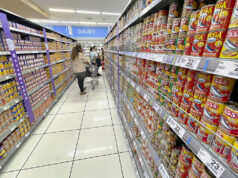Greenbacks and green buildings
By Sam L. Marcelo, High Life Associate Editor
[This article was published in BusinessWorld on April 27, 2012]
Every day, 500 copies of local and international newspapers are delivered to the Asian Development Bank Headquarters (ADB HQ) at 6 ADB Drive, Mandaluyong City. The triple-A rated international financial institution subscribes to nine local dailies and 35 foreign titles, including The Marshall Islands Journal, an independent weekly that serves as the only paper for a Micronesian nation of islands – population: 67,182 – in the middle of the Pacific Ocean.
Billion-dollar decisions are made in the granite-clad buildings designed by Skidmore, Owings & Merrill (SOM), an American architectural firm responsible for notable skyscrapers such as the Sears Tower in Chicago and Dubai’s Burj Khalifa, the tallest man-made structure in the world.
Aside from ADB HQ, SOM’s Philippine portfolio includes Ninoy Aquino International Airport Terminal 3 in Pasay City and PBCom Tower in Makati City.
Designed in 1983 and completed in 1991, ADB HQ cost $176 million to construct. The 6.5-hectare site in Mandaluyong, the country’s current mall mecca, was chosen based on the availability of land meeting the bank’s requirements.
“Our design philosophy was to relate the building to the cultural context of Asia, especially the Philippines, and to shape the buildings to respond to the tropical climate,” said Craig Kronenberg, SOM’s senior designer when ADB was built, in an e-mail interview with BusinessWorld.
In preparation for the ADB project, Mr. Kronenberg, now a partner at Hefferlin+Kronenberg Architects, and the rest of the SOM design team traveled throughout Asia and the archipelago, studying the way buildings were organized.
“The cloistered monasteries of Intramuros were compelling. The Philippine ancestral houses that have a heavy masonry base with a delicate wood frame and broad overhanging roof influenced our thinking. The way these house modulated light and air through a combination of capiz panels, shutters and windows fascinated us,” he said.

The ADB compound, he pointed out, is built around courtyards that define ground floor circulation – similar to a monastery with an arrival court leading to an entry hall fashioned like a cloister. This cloister, Mr. Kronenberg continued, encircles a garden with a fountain inspired by travels to India.
The nine-storey office tower block, which stands opposite and is linked to a two-storey facility block, was designed to maximize the amount of natural light available to occupants. The tropical climate of the Philippines influenced many of the structural features.
Recessed windows tinted light green allow light to enter while reducing heat. Aluminum grilles, which serve the same purpose as the capiz screens that fascinated the SOM design team, shade and reflect sunlight. Clerestories and skylights, such as the one in the cafeteria, bring in natural illumination.
Vertical elements reminiscent of the bell towers in Paoay, Ilocos Norte, mark the location of elevator lobbies. Aware that ADB HQ would sit in an area vulnerable to the Marikina Valley Fault System (which runs through Metro Manila), designers used the same vertical elements as shear walls that would buttress the structural frame during an earthquake.
According to Mr. Kronenberg, there were “strong incentives” to use materials from member countries. Hence floors made from Philippine marble, chairs and granite cladding from Italy, and Kone elevators from Finland.
“ADB is a modern mixed-use building influenced by its context. It was designed during the period of post-modernism. I prefer to call it contextualist,” he said, adding that the latter term captures a commitment to contribute to the built environment and to fit appropriately into the physical and cultural landscape.
“We embraced sustainable design decades before ‘green building’ became a catchphrase,” Mr. Kronenberg said. “We built with enduring materials that minimized life-cycle maintenance costs and served as a model for future building projects in the Philippines.”
RECOMMENDED: ADB President Takehiko Nakao on holding the ADB Annual Meeting in Manila after six years
CABINET OF CURIOSITIES
Twenty-one years after it opened, the ADB HQ remains a hive of activity. The bank has 67 member countries, from the population juggernaut that is China to Nauru, the world’s smallest republic. Around 55 of these 67 countries have representatives working in the office building.
In 2010, more than 2,200 staff members and 3,600 consultants and service providers (more than half of Nauru’s population of 10,000, in total) walked through the compound on an average business day.
Evidence of the international nature of the institution is everywhere. A display cabinet in the lobby, one of many, holds a Hakata doll from Japan, a chess set from Kyrgyz Republic, and a miniature woven carpet from Azerbaijan. Elsewhere, a mannequin dressed in an orange spacesuit donated by the US Government stares from behind its own glass case. As a policy, all gifts given to the ADB, including staff, are turned over to the organization.
Corridors become sites for revolving exhibitions about the ADB’s developing member countries. Today, Afghanistan is the focus. Two months from now, another country will be chosen. In preparation for the 45th Annual Meeting of the ADB, archival materials about the bank’s history are also on view.
Multiculturalism is further reflected in the ADB’s cafeteria, a pavilion of heavy timber that seats 1,000. Stations dedicated to Asian (Japanese, Chinese, etc.), Western, vegetarian and halal dishes prepare and serve almost 1,600 meals daily.

A “VIRTUAL MINI-CITY” THAT’S GREEN TO BOOT
Posted on the bank’s recruitment portal is an open letter from Hyong-Jong Yu, deputy director general of the ADB’s Budget, Personnel and Management Systems Department. The message informs candidates that “working at the ADB’s magnificent Manila headquarters is a benefit in itself.”
The “virtual mini-city,” Mr. Yu continues, features the following: in-house branches of major commercial banks; travel and insurance agencies; medical and dental clinics; courier services; telecommunications offices; executive dining rooms; laundry services, pharmacy, bookshop; library; convenience store; post office; and commissary.
He adds that there’s even a gymnasium complex with a large weight and cardiovascular room, two aerobics areas, squash/handball courts, ping pong tables, and a full basketball court with stands and scoreboard.
“Let’s just say you’ll be treated quite well,” ends Mr. Yu, who didn’t mention that the ADB has its own gas station.
Sitting in an ergonomic chair designed in-house, Ken L. Chee, director of the Facilities and Asset Management Division under the Office Administrative Services (OAS), explained that the ADB HQ’s amenities shouldn’t be thought of as luxuries. Instead, they are “enablers” that help employees maintain their work-life balance.
“The workplace environment is pretty high on our agenda, on a par with the mission of the bank,” he said. “Many of the people here work long hours. They might spend more time here than they do in their houses so we try to make a holistic environment for them.”
The OAS manages 144,000 square meters of space taken up by the ADB’s office tower block and special facilities block, along with the bank’s six-storey parking building.
Last year, the ADB became the first and only existing building in the Philippines to be certified gold for Leadership in Energy and Environmental Design (LEED). Aside from being the only international financial institution to obtain LEED gold certification, it is also among the biggest Asian buildings, in terms of floor area, to do so.
“We’re quite proud of our achievement,” said Mr. Chee, adding that it was a challenge since the ADB HQ is more than 20 years old. He compared the building to an aging person: “You need more maintenance,” he said. “What we’re trying to do here,” he continued, “is make the building more efficient.”
The ADB HQ’s dated equipment is offset by up-to-date process technology, explained lead facilities and management specialist Chatiya Nantham. “It’s just like trying to run a marathon at an old age,” he said, continuing Mr. Chee’s building-as-geriatric analogy. “You need to have proper techniques. In that perspective, we were able to improve our techniques and bring down our energy consumption and maintain our savings.”
As stated on the ADB’s Web site, the bank’s “long-term strategic framework for 2008-2020 identifies environmentally sustainable growth as a key strategic development agenda, and environment as a core area for support.” It goes on to say that the ADB “promotes and invests in sound environmental and natural resource management, while promoting green growth, low carbon development, and adaptation to climate change.” It is only proper that the ADB should innovate and lead the way in green practices.
“The idea is really for us to manage this building more efficiently and more effectively. The dollars and cents are there,” said Mr. Chee.
“It’s always dollars and cents. We can show you the numbers we have in terms of the targets and savings we managed to achieve.”



